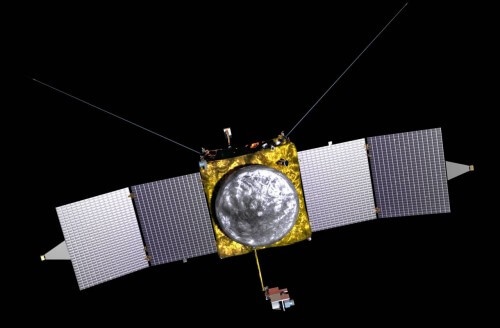Maven plans to explore the upper atmosphere of Mars and the interface between it and the solar wind, and in about a month also with the halo of Comet Sliding Spring that will pass by Mars

NASA's Maven Mars Atmosphere and Volatile Evolution (MAVEN) spacecraft will be put into orbit around Mars this Sunday, September 21, after completing a ten-month journey and covering a distance of about 700 million kilometers.
Flight controllers at Lockheed Martin's control center in Littleton, Colorado, will be responsible for the safety of the spacecraft during the process. The series of ignitions they will perform will place the spacecraft in orbit around Mars at 21:50 US Eastern Time (04:50 on September 22 Israel time).
"So far the performance of the spacecraft and its payload on the way to Mars is good," says David Mitchell, Maven Project Manager at NASA's Goddard Space Flight Center in Greenbelt, Maryland. "The crew, the flight systems and all the ground resources are ready to enter the runway."
The insertion maneuver into orbit will begin with the ignition of six small thrust engines designed to stabilize the spacecraft. The engines will spin for 33 minutes in the opposite direction of flight to slow the spacecraft, which will direct it into an elliptical orbit lasting 35 hours.
After entering orbit, Maven will begin the preparatory stages for the operation, which will last six weeks and will include maneuvering the spacecraft into a final orbit and testing its instruments and the scientific equipment on board, as well as seeing how it responds to commands for scientific mapping of Mars. Immediately after, Mayvan will begin its main mission, which will last one Earth year, to measure the composition and structure of the upper atmosphere and the gases escaping from it, as well as the mutual relationship between the Martian atmosphere and the solar wind.
"Maven's scientific mission is expected to answer questions such as where did the water that was common in ancient geological periods on Mars disappear, where did the carbon dioxide reservoirs go, and more." says Bruce Joski, Maven's principal investigator from the Laboratory for Atmospheric and Space Physics at the University of Colorado at Boulder. "These are important questions for understanding the history of Mars, the climate and the potential to support at least bacterial life.
In a few days, the Indian spacecraft MOM (Mars Orbiter Mission) will also enter orbit around Mars. The two will join the European spacecraft Mars Express and the American spacecraft MRO and Mars Odyssey.
Waiting for a comet to pass by Mars
On October 19th, all the Mars orbiting spacecraft and the two active ground rovers Curiosity and Opportunity will have their regular schedule to observe Comet Sliding Spring which is scheduled to pass near Mars on October 19th. Maven will examine the interface between the Martian atmosphere and the comet's halo.
As I recall, at first the astronomers believed that the comet was making its way collide with mars, but later calculations rule it out. As of today, the distance between them is expected to be so great that there is only a chance for the edge of the comet's cloud of dust particles to pass near the Martian atmosphere. Maven will anyway photograph the comet's core and its halo and measure the rate of dust emission from the core.
For news about Maven's entry into orbit on the NASA website
The Maven spacecraft page on the NASA website
